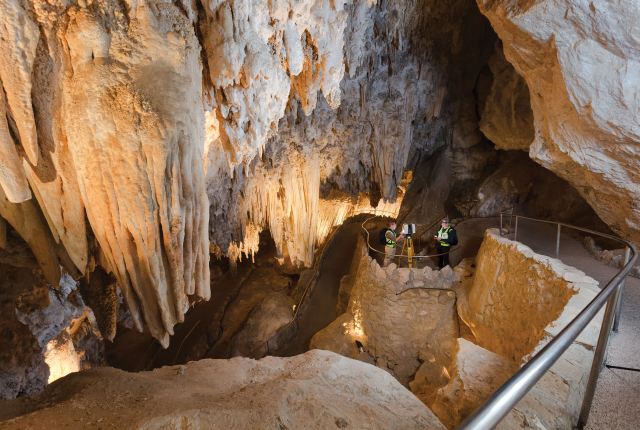CARLSBAD CAVERNS IS UNIQUE for the rock that it occupies and how it formed. Most caves form from the top down, but sulfuric acid helped create these from the bottom up. A few factors had to combine to make that possible: Saltwater and freshwater mixed to “Swiss-cheese” the rock; bacteria living just above the water table in that spongy rock digested sulfur and produced sulfuric acid; and the acid converted limestone (once part of an ancient reef) into gypsum that dissolved in water, leaving behind massive cavities.
At one time, the walls would have been coated with yellow sulfur crystals and might have smelled like rotten eggs.
Look overhead. Notice the arch-like cathedral ceiling? An arch is the strongest shape for supporting a load, so rock erodes from the walls until that arch is created and the cave stabilizes.
Over the past half-million years, columns formed when something from the ceiling reached down, or something on the cave floor built up toward the ceiling. The direction in which a form grows depends on how quickly water is dripping, which, in turn, is determined by the moisture level of the surface environment. Ancient climates—the ends of ice ages, glaciers melting, a shift in the prevailing winds blowing far overhead—are recorded in the way columns billow and change shape.“What you’re looking at here is a change in the drip rate, frozen in time,” says Mark Joop, a ranger, caver, and geologist at Carlsbad Caverns National Park since 2010.
Thicker stalagmites reflect an era when you’d have found a field of glaciers aboveground, rather than the desert seen today. Traveling through the layers of rock to reach the caverns takes water more than 30 years, so the caves have not yet felt the effects of the past 20 years of drought in the Southwest. When they do, it will likely further starve these features.
Read more: Make the most of your time in and around Carlsbad.
Most of the processes that formed these caverns and their features were geological—but one was biological. Bacteria grew in strings that dangled from the shelf stone into water high in calcium carbonate. The calcite adhered to the strings of bacteria, like rock candy, and became self-fossilized. “We never thought that would be possible,” Joop says, “and it was discovered here.” Look for pinkish “pool fingers” by the old amphitheater seating area, and at the Painted Grotto, an alcove near number 46 on the audio tour.
In massive pillars like Rock of Ages and Three Giants, water drips onto the growing stalagmite and scatters in a sheet that flows down the sides only so far, then evaporates. That makes a ledge, which then curves under and divides into fingers, resulting in the tiers seen now.

Sulfuric acid helped create Carlsbad Caverns formations from the bottom up. Illustration by Chris Philpot.
Cave popcorn forms when drips splash onto the tops of pillars and scatter their mineral content. Often, it forms next to pillars, but not always. Look closely at the popcorn-filled field at Fairyland and you’ll see some forms that aren’t attached to pillars at all—they’re just heaps of popcorn. But popcorn forms only to a certain height, and scientists aren’t certain why—something in the atmosphere of the evolving cave created a climate that allows it only to a certain point. A fun view of this line shows in the Lion’s Tail, where smooth stalactites grew into that zone and sprouted tufted ends.
Take in the scope of the Big Room, the largest single chamber in the United States (about the size of six football fields), from the high point next to the Rock of Ages. The 360-degree view looks down the cavern (away from the elevators), with the farthest point visible a quarter mile away.

The Chandelier is where flowstone stretches as far as 30 feet from the ceiling. Illustration by Chris Philpot.
Draperies form when water runs down the ceiling at an angle, one drip following a path of least resistance and then creating a route all the others follow. As the water runs, it deposits calcite along its circuitous path—“water molecules seem to like to tumble,” ranger Mark Joop says—forming a fin that’s only as wide as that drop of water. The most impressive of these is the Chandelier, where flowstone stretches as far as 30 feet from the ceiling. Want to better appreciate its twists and turns? At the bridge over Longfellow’s Bathtub (the long, narrow pool), look overhead to see another flowstone’s folds from below.
The entire cave floor once pooled with water. Where calcite-laden water ran off stalagmites into those still pools, the surface tension could sometimes hold aloft a raft of translucent minerals. Those rafts hardened into rims around the pools’ edges—“shelf stone” that now hovers over dust and bare rock. See rims of it just past the Temple of the Sun or at the wayside marker on Lily Pads, near the shortcut, where those rafts grew into islands.
Conditions sometimes led to the formation of Bell Canopies, thicker rims with cords of stone below. bell canopies are best spotted near audio-tour marker number 41, at the largest still-active stalagmite in the caverns.


